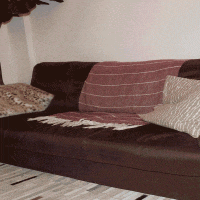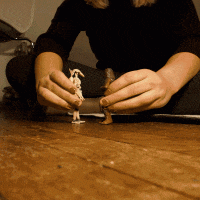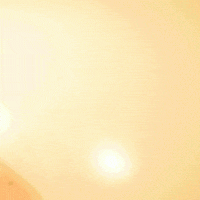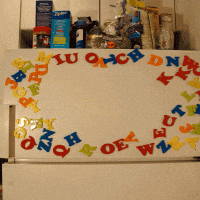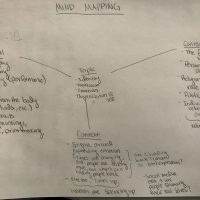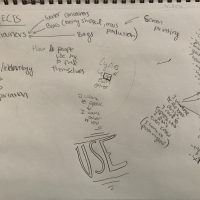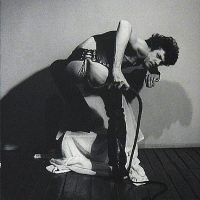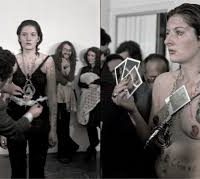Émile Cohl’s Fantasmagorie is the first animated cartoon. The animation was created by shooting 700 drawings onto negative film to give the effect of white on black. The photos were also double exposed in order to make the running time longer, almost a full two minutes. This film is considered to be a stream of consciousness style, which gives the cartoon its random subject matter and easy and fluid transitions. The character in Fantasmagorie, Fantoche, reappears in some of his over 250 films created between 1908 and 1923. When Fantasmagorie was released, Cohl also released two films called “The Puppet’s Nightmare” and “A Puppet Drama” which both have the same style and random plot lines as Fantasmagorie. He inspired other animators such as Winsor McCay, Raoul Barré, John Randolph Bray, and Paul Grimault, who all drew hand drawn animations. Cohl was attributed with further development to the artistic style of animation along with short narrative storytelling.
Category: Uncategorized
5, 5 Frames
Bridge 2 -Mind Mapping
Mind Maps and Images of Inspiration:
Links:
http://www.tate.org.uk/art/artworks/jones-chair-t03244
Project 7 – Project Proposal
Concept Phrases
Photographic map of male and female bodies oriented in ways that oppose their sexes.
Gender norms being transformed and blurred by the ways of acceptance and a refreshing eye for beauty.
Paragraph
For this project I would like to explore the technical uses of a film camera, using the 2-D medium to show the reality of gender norms in today’s society. Using four subjects, two biologically female and two biologically male, I will dress and position the subjects in such a way, with the use of clothing, make-up, and posing, that will blur their gender lines and make them look as if they were of the opposite sex. I will experiment with the use of lighting and staging, as well as the proceeding steps of developing the film.
Image Collage
These images show some of my ideas for lighting, angles, and expressive body language that I would like to emanate in my photo series. I especially would like to focus on poses that explore the range of motion of the body and the extent of its ability to abstract the human form. My lighting and camera positioning will highlight these qualities of the body.
Action Plan
This up coming weekend, with the help of a friend majoring in photography who is also well versed in film cameras, I will take photos of myself and one of the other subjects to see how the camera works and experiment with posing and lighting. I will then develop this film and see the results, after reviewing the photos I will either move on taking photos of the next two subjects, or photograph all four subjects with information gained from the first set of photos. I am hoping to do everything as soon as possible as I have to take in to account the time to develop the film and then assess whether or not the developed photos demonstrate what I want to show.
Read Before You Start!
By uploading files to a learning portfolio site to share with others, students are declaring that they created the content or that they have the right/permission to distribute this material within a class (in the case of Canvas) or on the Internet (in the case of uploading to a learning portfolio site). Should you have any questions about how to acquire this permission or your use of the materials, please see the Copyright & Citation tab on the Library’s Images for Designers and Art Researchers page or email ereserves@newschool.edu.
Welcome to the Parsons Learning Portfolio!
The Learning Portfolio is where you will tell your Parsons story. If you have questions or would like to learn more about the many ways you can design your portfolio, be sure to visit the Student Resources + Support site at portfolio.newschool.edu/studentsupport. But before you do, be sure to read the About pages under Courses and Topics in the menu bar and in the Links section of the footer, as well as the other three posts found on the homepage.
As a student at The New School, you can create as many blogs as you wish. But when you first registered for your Learning Portfolio at portfolio.newschool.edu, a portfolio/blog was created for you with your Net. Id. at the end of the URL, e.g. http://portfolio.newschool.edu/YourNetId. Hopefully, that’s the blog you’re reading right now. Have a look at the address bar for confirmation. It’s important that you use that blog—that URL—as your Learning Portfolio. It makes it possible for your instructors and classmates to find your Learning Portfolio. To learn about privacy settings, see the Help menu.
The Learning Portfolio is a tool with which you will engage throughout your education at Parsons (and perhaps beyond). The focus of the Learning Portfolio is on reflection, on looking across your many courses and semesters and the various assignments and projects throughout the curriculum. The portfolio is a way for you to examine your own progress and performance, to share your work with others, and to tell a story about your time on campus (New York, Paris, and elsewhere).
Finding Your Way Around the Learning Portfolio
Get to know the layout of the learning portfolio.
Theme
The WordPress theme used by the learning portfolio is called Tetris – Newschool.edu. Continue reading “Finding Your Way Around the Learning Portfolio”
The Importance of Categories and Tags
By the end of your first semester, you will have posted a lot of content to your learning portfolio. One of the challenges for you, your instructors, potential employers, family and friends will be sorting through it all. The Courses and Topics menus based on categories and tags, the tag list, your post titles and the search box are all ways of finding things in your portfolio, but Categories and Tags are the two most important. Both help you reflect back on the work, but they also give visitors a way to understand the relationship that exists across the images, text, videos, and other content that you’ve created in the various projects, classes, or years at Parsons.
As mentioned elsewhere, Categories and Tags are two means of aggregating and presenting related content in your portfolio. Your learning portfolio comes pre-populated with categories for each of the courses you will be taking in your first year at Parsons. It also come pre-populated with over 60 tags for you to use, but you can create new ones at any time. Log into the Dashboard of your learning portfolio to see the full list of categories and tags. You will find both under the Posts tab.
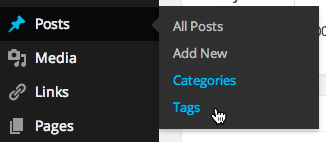
So whenever you make a post, be sure to assign a category for the relevant course and year and add relevant tags that might be thematic or as specific as the name of the course project the post relates to. For example, your final project in Space & Materiality might require you to develop a proposal, preliminary sketches, some historical or technical research, a prototype and a final product. These might be uploaded in separate posts, each of which could be tagged as Space Final Project. To find them all, one would simply click on the tag in the tag list or at the bottom of one of the posts to pull them all together under the heading of Posts Tagged “Space Final Project”.
This post has been assigned the tag of LP Instructions. You’ll see the tag at the bottom of the post, in the sidebar and in the footer. Click on it in any of the three locations to see what happens. On the first day of the semester, the result will look a lot like the homepage—four posts about the learning portfolio—but over time, these posts will get buried amongst all of the other content you’ll be posting to your portfolio. To find any of them, all you’ll need to do is click on the LP Instructions tag.
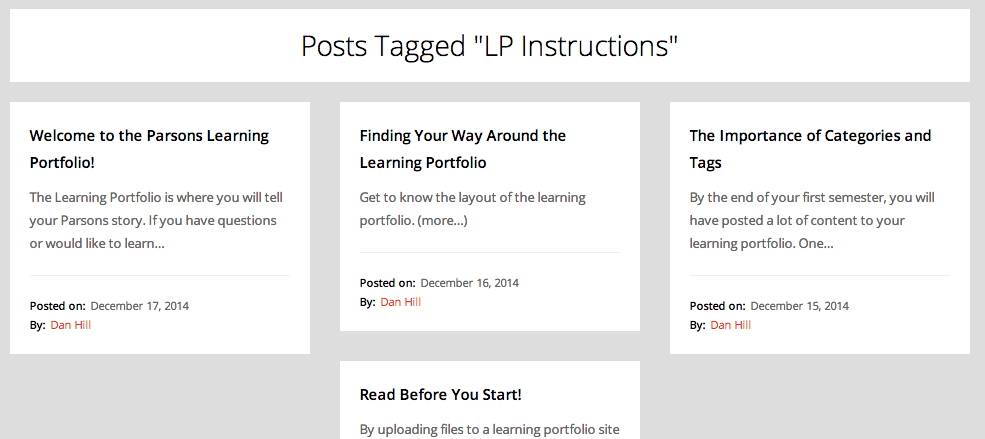
Wouldn’t it be nice to be able to do that for each of your projects or themes you’ll be exploring?
Though less selective, the search box is another way to find things in your portfolio. You will get much better search results if you put some thought into giving each post a concise but descriptive title.
- More information about categories and tags can be found here.
